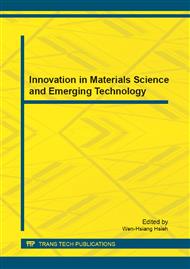p.1
p.6
p.11
p.16
p.21
p.27
p.32
p.37
p.43
Micro Palm and Kenaf Fibers Reinforced PLA Composite: Effect of Volume Fraction on Tensile Strength
Abstract:
Extensive environmental concern associated with the disposal of solid plastic wastes has stirred tremendous interest in the production and use of sustainable biodegradable polymers. Among the vast variety of available materials, Polylactic Acid (PLA) standout as the most commercially viable mass produced resin to date. However, its low thermal and mechanical stability, excessive brittleness, and relatively higher cost have led to numerous research efforts in producing biodegradable polymer composite filled with natural organic fibers. This paper describes the preparation and the mechanical characteristics of a compression molded biodegradable composite made entirely of renewable raw materials. The composites were reinforced with pulverized palm, kenaf and alkali (1M NaOH:fiber in ratio 2:1) treated kenaf fibers, at a fiber mass proportion of 20 to 60% blended PLA and processed in a custom-built compression mold. SEM microscan revealed that the kenaf fiber has a mean diameter of 40μm, length 1236.6μm, and aspect ratio of 31 while the measured values for palm fiber was 58.7μm, 1041.2μm, and 17.7, respectively. All resulting composites showed significant enhancement in tensile strength. At 20, 40 and 60% fiber loading, the palm/PLA composite recorded tensile strength increment of 46.9, 47.8 and 36.6%, respectively. For the kenaf/PLA composite, greatest improvement was achieved at 40% fiber loading with alkali treated kenaf, with approximately 54% higher than the neat PLA while only 12.6% was recorded for the non-treated kenaf/PLA composite, signifying that the surface modification greatly improved fiber-matrix adhesion. SEM observations on the fracture surface showed similar findings. Compared to commercially available palm/Polypropylene (palm/PP) composite at 50% fiber loading, our measured tensile strength for the PLA composite loaded with 40% alkali treated kenaf fiber was still about 20% lower. Further enhancement in the mechanical characteristic of the kenaf/PLA composite is required to push for its wider utilization in the polymer industry.
Info:
Periodical:
Pages:
1-5
Citation:
Online since:
December 2011
Authors:
Price:
Сopyright:
© 2012 Trans Tech Publications Ltd. All Rights Reserved
Share:
Citation:


